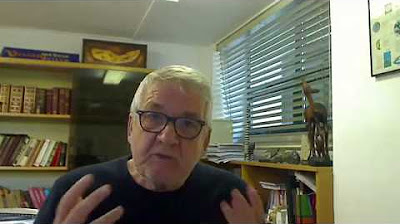Kuliah 10 Baku Mutu Udara Full00
Summary
TLDRIn this lecture, the instructor discusses Indonesia's government regulation (PP 22/2021) on air quality management, focusing on its importance for protecting and managing environmental air quality. The regulation emphasizes the control of air pollution and the necessity of integrating efforts at a national level. Key topics include the classification of air quality, the establishment of air quality standards, and air pollution control methods. The lecture covers various aspects of air management, including emission sources, ambient air quality, and legislative measures for managing industrial and vehicular pollution. It provides insight into the ongoing efforts to preserve air quality for the well-being of both people and the environment.
Takeaways
- 😀 The importance of environmental air quality and air pollution control is highlighted, particularly focusing on the regulation set out in PP 22/2021.
- 😀 PP 22/2021 is a regulation stemming from the 2020 Job Creation Law (Omnibus Law), which consolidates and amends previous environmental laws, especially those regarding air quality and pollution control.
- 😀 Air pollution sources, known as emission sources, can be anthropogenic (human-made), such as vehicle exhausts and factory chimneys, and can significantly degrade ambient air quality.
- 😀 Decreased air quality has various environmental impacts, including impaired visibility, respiratory issues, and health problems like lung cancer, as well as harm to plants and animals.
- 😀 There is a need for integrated air quality protection and management strategies, which are set out in regulations that define how to address air pollution in a national context.
- 😀 PP 22/2021 outlines four key areas of air quality management: air inventory, ambient air quality standards, air quality protection areas (WPMU), and emission standards.
- 😀 The air quality inventory includes the collection and analysis of data on air quality, emissions, and sources of pollution, as well as the methods for measurement.
- 😀 The regulation sets specific standards for ambient air quality (baku mutu udara ambien), with an emphasis on balancing health, social, and economic considerations.
- 😀 WPMU (air quality protection areas) are divided into different categories (e.g., national, provincial, or city-level) based on air quality standards and emissions data.
- 😀 The regulation also covers air pollution control efforts, including prevention, mitigation, and recovery, with a focus on methods such as emission reduction quotas and pollution monitoring systems.
Q & A
What is the main topic of the lecture?
-The lecture focuses on air quality standards as outlined in PP 22 of 2021, a regulation derived from the 2020 Omnibus Law on Job Creation. It discusses the protection and management of air quality, including emission sources and ambient air quality.
What is the significance of PP 22/2021 in environmental law?
-PP 22/2021 is a significant regulation in Indonesia's environmental law, as it serves as a derivative of the 2020 Omnibus Law and updates previous regulations related to environmental management, including air quality, water quality, and pollution control.
What are the two types of emission sources mentioned in the lecture?
-The two types of emission sources are 'moving sources' (such as motor vehicles and heavy machinery) and 'stationary sources' (such as factories and power plants).
What is 'ambient air quality' and why is it important?
-Ambient air quality refers to the condition of the air in a specific area, influenced by pollution levels. It is important because it impacts human health, ecosystems, and the overall quality of life.
What does 'WPMU' stand for and what does it refer to?
-WPMU stands for 'Wilayah Perlindungan dan Pengelolaan Mutu Udara', which translates to 'Air Quality Protection and Management Area'. It refers to specific regions designated for planning and managing air quality protection.
How does the regulation categorize regions for air quality management?
-The regulation categorizes regions into three classes based on their intended use: Class 1 for clean air areas, Class 2 for residential, commercial, and agricultural zones, and Class 3 for industrial areas.
What is the role of emission inventories in air quality management?
-Emission inventories are crucial for tracking and analyzing the sources of air pollution. They help in the planning and formulation of policies to manage and reduce pollution.
What is the process of determining 'Baku Mutu Udara' (ambient air quality standards)?
-The process involves measuring air pollution levels, considering health, social, economic, and environmental factors, and setting thresholds for permissible pollutant concentrations in the air.
What are the main actions involved in air pollution control as outlined in the regulation?
-Air pollution control involves prevention, mitigation, and recovery actions. This includes using emission standards, providing public information, halting pollution sources, and applying technology to clean up pollutants.
What does the regulation say about emissions from moving sources?
-Emissions from moving sources, like vehicles and transport machinery, are regulated based on their emission levels. Different emission standards apply to new models and existing vehicles, with ongoing monitoring to ensure compliance.
Outlines

This section is available to paid users only. Please upgrade to access this part.
Upgrade NowMindmap

This section is available to paid users only. Please upgrade to access this part.
Upgrade NowKeywords

This section is available to paid users only. Please upgrade to access this part.
Upgrade NowHighlights

This section is available to paid users only. Please upgrade to access this part.
Upgrade NowTranscripts

This section is available to paid users only. Please upgrade to access this part.
Upgrade NowBrowse More Related Video

PENGUKURAN PENCEMARAN UDARA AMBIEN | Labtalk #25

Wajib Tahu Amdal, UKLUPL dan Persetujuan Lingkungan

PENCEMARAN LINGKUNGAN- Video Animasi Materi Pencemaran Udara SMP Kelas 7

Lingkungan & Kependudukan (bag 2) : Kualitas Lingkungan Hidup #kumer

Introduction to Geostatistics Part III Module 1

How Do Environmental Agencies Function Within Government Roles? - Civil Service Study Center
5.0 / 5 (0 votes)